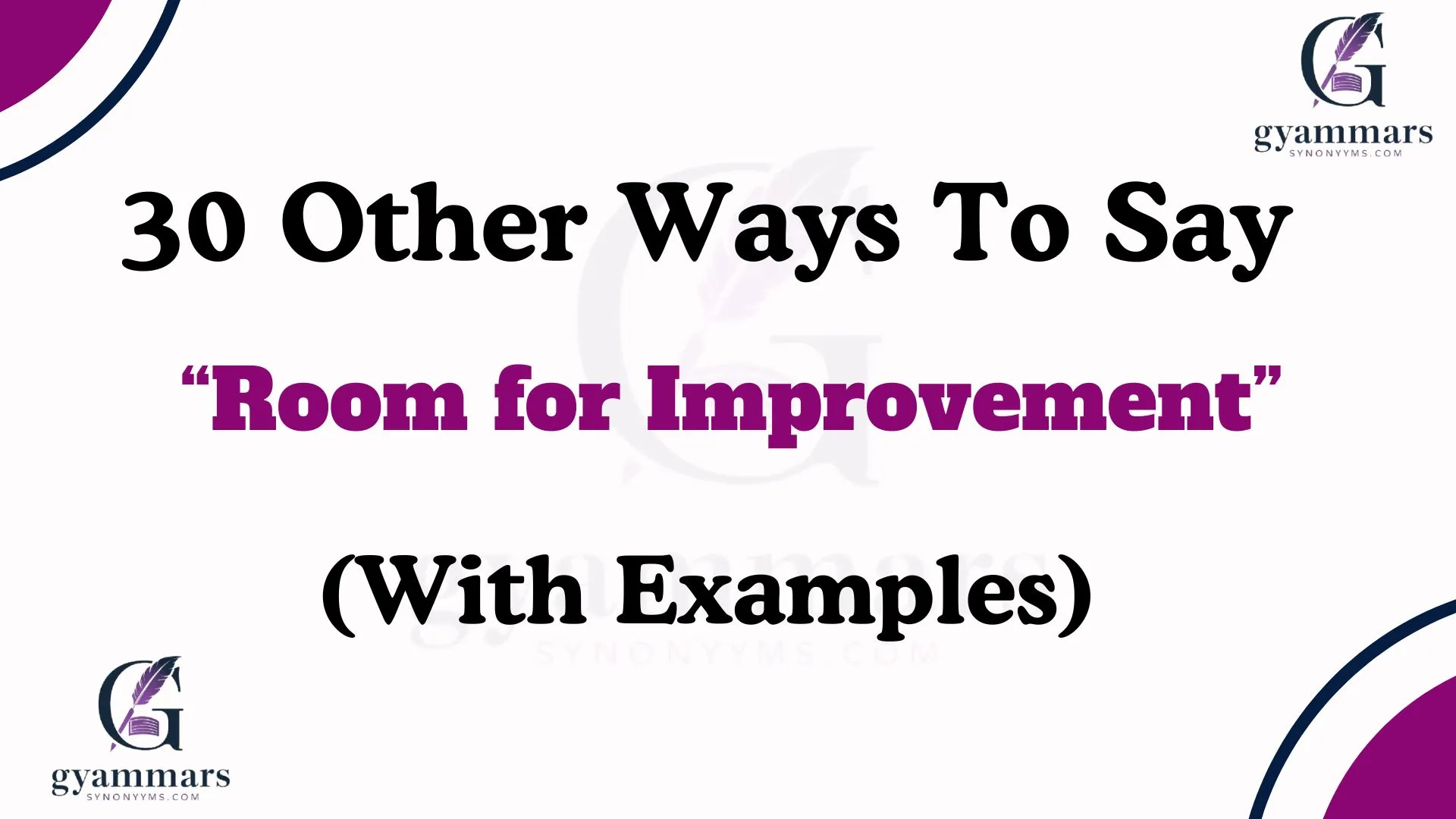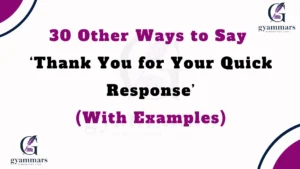Finding the right words matters, especially when giving feedback. You want to be thoughtful, encouraging, and constructive while avoiding harshness. The phrase “room for improvement” is widely used, but there are many other warm and professional alternatives that can make your message feel more personal and motivating.
In this article, you’ll discover 30 alternatives to “room for improvement,” complete with definitions, examples, and best-use cases to help you communicate with care.
What Does “Room for Improvement” Mean?
The phrase “room for improvement” refers to a situation, skill, or outcome that is good but has the potential to get better. It acknowledges progress while encouraging further growth without being overly critical.
For example, if you say, “Your presentation was great, but there’s room for improvement in delivery,” you are implying that the work is good but could be enhanced.
Is It Professional/Polite to Say “Room for Improvement”?
Yes, “room for improvement” is generally polite and professional. However, it can sometimes sound vague or impersonal, especially in sensitive situations.
A more personalized or specific phrase might be better, depending on the tone and context. That’s where these alternatives come in handy.
Pros and Cons of Using “Room for Improvement”
Pros:
- Neutral and constructive
- Widely accepted in professional settings
- Encourages growth without being too critical
Cons:
- May sound generic or impersonal
- Can feel vague without additional context
- Might not always fit sensitive conversations
Synonyms For “Room for Improvement”
- Potential for Growth
- Areas to Enhance
- Opportunity to Improve
- Scope for Refinement
- Work in Progress
- Refinement Needed
- Chance to Elevate
- Fine-Tuning Required
- Steps Toward Perfection
- Areas Worth Strengthening
- Ways to Improve
- Adjustments to Consider
- Additional Improvements Possible
- Chance to Grow
- Fine-Tuning Opportunities
- More to Build On
- Potential for Enhancement
- Further Development Needed
- Next Level Improvements
- Possible Advancements
- Opportunities to Strengthen
- Room for Advancement
- Areas to Improve Upon
- Scope to Build Further
- Further Optimization
- Space for Growth
- Fine-Tuning Possibilities
- Performance Enhancement Areas
- Development Potential
- Further Polishing Required
1. Potential for Growth
Definition: This phrase highlights the ability to develop and progress further.
Explanation: It suggests that there is opportunity for improvement, but in an encouraging and positive way.
Scenario Example:
“Your leadership skills have strong potential for growth. Keep refining your approach, and you’ll see great results.”
Best Use: When offering motivational feedback in professional or personal settings.
Tone: Encouraging and forward-looking.
Additional Notes: Works well in career and personal development discussions.
2. Areas to Enhance
Definition: Identifies specific aspects that could be improved.
Explanation: This is a constructive phrase that focuses on refining key areas rather than pointing out flaws.
Scenario Example:
“Your report is well-structured, and there are a few areas to enhance for clarity.”
Best Use: When giving specific feedback on performance or skills.
Tone: Supportive and actionable.
Additional Notes: Works well for structured feedback in work or education.
3. Opportunity to Improve
Definition: Emphasizes the chance to make something better.
Explanation: This phrase makes improvement feel like an exciting opportunity rather than a shortcoming.
Scenario Example:
“Your design is already strong, and you have a great opportunity to improve the user experience.”
Best Use: In positive and growth-oriented conversations.
Tone: Optimistic and motivational.
Additional Notes: Works well when framing feedback as a learning experience.
4. Scope for Refinement
Definition: Indicates that small improvements could enhance the overall result.
Explanation: This phrase is often used when something is already strong but could be polished further.
Scenario Example:
“Your writing is compelling, with scope for refinement in sentence structure.”
Best Use: When offering fine-tuning suggestions.
Tone: Professional and constructive.
Additional Notes: Useful in editing, reviewing, and performance assessments.
5. Work in Progress
Definition: Suggests that something is still evolving and developing.
Explanation: This phrase conveys that the process is ongoing and improvement is expected.
Scenario Example:
“Your project is a work in progress, and with a few adjustments, it will be outstanding.”
Best Use: When emphasizing continuous improvement.
Tone: Casual yet supportive.
Additional Notes: Works well in creative and collaborative settings.
6. Refinement Needed
Definition: Suggests that small adjustments could enhance overall quality.
Explanation: This phrase implies that the work is already good but could benefit from fine-tuning.
Scenario Example:
“Your coding style is solid, but a bit of refinement is needed in structuring your functions.”
Best Use: When giving detailed or technical feedback.
Tone: Professional and constructive.
Additional Notes: Ideal for performance reviews and quality assessments.
7. Chance to Elevate
Definition: Emphasizes an opportunity to take something to a higher level.
Explanation: This phrase is encouraging and motivating, making improvement feel aspirational rather than critical.
Scenario Example:
“Your marketing strategy is effective, but there’s a great chance to elevate brand engagement further.”
Best Use: When you want to motivate and uplift.
Tone: Positive and inspiring.
Additional Notes: Works well in growth-oriented discussions.
8. Fine-Tuning Required
Definition: Highlights minor improvements to enhance performance.
Explanation: This phrase is useful when something is already well-developed but needs small adjustments.
Scenario Example:
“Your violin performance was outstanding, just a little fine-tuning required on tempo control.”
Best Use: When discussing high-level improvements.
Tone: Encouraging and precise.
Additional Notes: Ideal for artistic and skill-based feedback.
9. Steps Toward Perfection
Definition: Suggests that progress is being made, with just a few more steps needed.
Explanation: This phrase adds a growth mindset perspective, acknowledging effort while highlighting room for enhancement.
Scenario Example:
“You’re making great progress on your public speaking—just a few more steps toward perfection with pacing.”
Best Use: When recognizing effort and progress.
Tone: Supportive and goal-oriented.
Additional Notes: Great for mentorship and coaching.
10. Areas Worth Strengthening
Definition: Identifies specific aspects that could benefit from more focus.
Explanation: This phrase points out key areas where improvement would be most valuable.
Scenario Example:
“Your writing is engaging, and there are some areas worth strengthening in your argument development.”
Best Use: When providing focused and structured feedback.
Tone: Professional and constructive.
Additional Notes: Works well for academic and corporate settings.
11. Ways to Improve
Definition: A broad phrase suggesting several possible improvements.
Explanation: This keeps the feedback open-ended and adaptable to different contexts.
Scenario Example:
“Great work on the project! Here are some ways to improve efficiency for next time.”
Best Use: When giving general yet constructive feedback.
Tone: Neutral and adaptable.
Additional Notes: Best for general performance discussions.
12. Adjustments to Consider
Definition: Suggests potential changes without being too directive.
Explanation: This phrase makes improvement feel like a suggestion rather than a requirement.
Scenario Example:
“Your proposal is strong; here are a few adjustments to consider before submission.”
Best Use: When you want to suggest improvements gently.
Tone: Polite and collaborative.
Additional Notes: Works well in peer reviews and teamwork.
13. Additional Improvements Possible
Definition: A phrase that acknowledges current progress while suggesting further refinement.
Explanation: This phrase keeps feedback open and encouraging.
Scenario Example:
“Your design is impressive, but there are additional improvements possible for mobile responsiveness.”
Best Use: When discussing iterative improvements.
Tone: Supportive and forward-thinking.
Additional Notes: Ideal for ongoing projects and product development.
14. Chance to Grow
Definition: Highlights an opportunity for personal or professional development.
Explanation: This phrase frames improvement as a positive growth opportunity rather than a flaw.
Scenario Example:
“Your leadership has been great, and this challenge is a chance to grow even further.”
Best Use: When focusing on self-improvement and motivation.
Tone: Inspirational and constructive.
Additional Notes: Useful for mentorship and coaching.
15. Fine-Tuning Opportunities
Definition: Small chances to improve details and overall impact.
Explanation: This phrase highlights precision-oriented improvements.
Scenario Example:
“Your presentation was well-researched, with fine-tuning opportunities in delivery style.”
Best Use: When discussing small yet impactful refinements.
Tone: Encouraging and detail-oriented.
Additional Notes: Great for high-performance industries and creative fields.
16. More to Build On
Definition: Highlights that the current work provides a good foundation but can still be expanded.
Explanation: This phrase reassures that progress has been made, but there’s still potential to develop further.
Scenario Example:
“Your business plan is strong, and there’s more to build on regarding market research.”
Best Use: When acknowledging effort but encouraging further progress.
Tone: Supportive and constructive.
Additional Notes: Useful in team projects and mentorship.
17. Potential for Enhancement
Definition: Suggests that something can be improved to become even better.
Explanation: This phrase is neutral and professional, making it great for formal discussions.
Scenario Example:
“Your website layout is well-structured, but there’s potential for enhancement in the user interface.”
Best Use: When providing formal feedback with a focus on refinement.
Tone: Professional and polite.
Additional Notes: Ideal for business and performance reviews.
18. Further Development Needed
Definition: Indicates that additional work or research is necessary.
Explanation: This phrase suggests that progress has been made, but more effort is required.
Scenario Example:
“The app prototype looks promising, but further development is needed for seamless functionality.”
Best Use: When something is incomplete or requires substantial work.
Tone: Neutral and clear.
Additional Notes: Best for early-stage projects.
19. Next Level Improvements
Definition: Encourages someone to step up their game and refine their work further.
Explanation: This phrase makes improvement feel exciting rather than corrective.
Scenario Example:
“Your video editing skills are great—some next-level improvements in transitions would make it even better!”
Best Use: When motivating creative or performance-based growth.
Tone: Encouraging and energetic.
Additional Notes: Great for mentorship and coaching.
20. Possible Advancements
Definition: Implies that there are several ways to make something better.
Explanation: This phrase keeps feedback open-ended and flexible.
Scenario Example:
“This AI model works well, but there are possible advancements in accuracy and speed.”
Best Use: When discussing technological or research-based work.
Tone: Professional and exploratory.
Additional Notes: Ideal for R&D and innovation settings.
21. Opportunities to Strengthen
Definition: Points out specific areas that can be reinforced.
Explanation: This phrase is supportive and action-oriented.
Scenario Example:
“Your leadership style is effective, and there are opportunities to strengthen your delegation skills.”
Best Use: When giving targeted advice on skill development.
Tone: Supportive and direct.
Additional Notes: Perfect for professional development feedback.
22. Room for Advancement
Definition: Suggests that progress can still be made.
Explanation: This phrase is neutral and practical, ideal for evaluations.
Scenario Example:
“You’ve made great strides in coding, and there’s room for advancement in debugging techniques.”
Best Use: When evaluating progress over time.
Tone: Professional and constructive.
Additional Notes: Works well in job performance reviews.
23. Areas to Improve Upon
Definition: Pinpoints specific sections that need attention.
Explanation: This phrase softens constructive criticism by making it about opportunities rather than flaws.
Scenario Example:
“Your essay is compelling, and there are a few areas to improve upon in argument structure.”
Best Use: When offering detailed feedback.
Tone: Helpful and encouraging.
Additional Notes: Best for academic and creative work.
24. Scope to Build Further
Definition: Indicates that the foundation is there, but there’s more to be done.
Explanation: This phrase suggests that the work is in progress and evolving.
Scenario Example:
“Your startup idea is promising, with scope to build further on revenue strategies.”
Best Use: When discussing growth potential.
Tone: Optimistic and strategic.
Additional Notes: Ideal for business and entrepreneurial settings.
25. Further Optimization
Definition: Suggests that something works well but could be made more efficient.
Explanation: This phrase is great for technical or performance-driven discussions.
Scenario Example:
“Your SEO strategy is effective, but there’s room for further optimization in keyword targeting.”
Best Use: When discussing efficiency improvements.
Tone: Professional and analytical.
Additional Notes: Best for business and technology discussions.
26. Space for Growth
Definition: Suggests an ongoing journey of improvement.
Explanation: This phrase keeps feedback open-ended and positive.
Scenario Example:
“Your leadership skills are strong, and there’s space for growth in conflict resolution.”
Best Use: When discussing long-term development.
Tone: Supportive and aspirational.
Additional Notes: Ideal for career and personal growth conversations.
27. Fine-Tuning Possibilities
Definition: Indicates minor yet valuable refinements.
Explanation: This phrase suggests small adjustments that could enhance overall quality.
Scenario Example:
“The research report is detailed, with fine-tuning possibilities in data visualization.”
Best Use: When discussing minor refinements.
Tone: Encouraging and specific.
Additional Notes: Best for technical and creative feedback.
28. Performance Enhancement Areas
Definition: Pinpoints aspects that could be improved for better outcomes.
Explanation: This phrase is often used in athletic, business, or work performance discussions.
Scenario Example:
“Your public speaking is engaging—some performance enhancement areas include pacing and vocal variety.”
Best Use: When discussing skills and efficiency.
Tone: Professional and constructive.
Additional Notes: Works well for coaching and evaluations.
29. Development Potential
Definition: Highlights the long-term possibilities for improvement.
Explanation: This phrase encourages growth by focusing on potential rather than shortcomings.
Scenario Example:
“Your writing has strong development potential in creating more compelling narratives.”
Best Use: When discussing long-term improvement strategies.
Tone: Encouraging and forward-looking.
Additional Notes: Great for education and career planning.
30. Further Polishing Required
Definition: Suggests that something is near completion but needs final touches.
Explanation: This phrase is best used when improvement is minimal yet necessary.
Scenario Example:
“Your artwork is stunning—just a little further polishing required on shading details.”
Best Use: When discussing final refinements.
Tone: Encouraging and detailed.
Additional Notes: Ideal for creative fields and quality control.
Conclusion
Finding the right words to express “room for improvement” can make all the difference in how feedback is received. Whether you’re offering constructive criticism, coaching, or professional evaluations, choosing a phrase that conveys support, encouragement, and positivity can help motivate others to grow without feeling discouraged.
From gentle suggestions like “more to build on” to professional alternatives like “opportunities for refinement,” each of these 30 alternatives provides a way to frame feedback with thoughtfulness and care.
By using these empathetic and constructive phrases, you can foster a culture of growth, collaboration, and continuous improvement—whether in the workplace, creative projects, or personal development. 🌱✨
FAQs
1. Why should I avoid saying “room for improvement” directly?
While “room for improvement” isn’t offensive, it can sometimes sound vague or uninspiring. Using a more thoughtful or personalized phrase can make feedback feel encouraging rather than critical.
2. What’s the most professional way to express “room for improvement”?
Phrases like “opportunities for refinement,” “potential for enhancement,” or “further development needed” work well in professional settings. These alternatives acknowledge progress while suggesting areas for growth in a respectful manner.
3. How can I make my feedback sound more encouraging?
Use positive framing by focusing on what’s already working well and presenting areas for improvement as opportunities rather than flaws. Phrases like “more to build on” or “next-level improvements” help keep the tone uplifting.
4. What’s the best way to give constructive criticism without sounding harsh?
Be specific, kind, and solution-oriented. Instead of just pointing out issues, offer actionable suggestions. Saying “This is a great start, and there’s scope to build further” is much more motivating than “This isn’t good enough.”
5. Can I use these alternatives in formal business settings?
Yes! Many alternatives, like “areas for growth” or “performance enhancement areas,” are suitable for corporate meetings, performance reviews, and project evaluations.

“Emma Brooke at Grammar Synonyms is your trusted source for mastering the art of language. Whether you’re looking for the perfect synonym, refining your grammar, or searching for that one ideal phrase, we’ve got you covered. With a wealth of tools and resources, Emma Brooke brings you creative solutions for all your writing needs, making sure your words always hit the mark. Unlock a world of language possibilities and elevate your writing with ease.”












